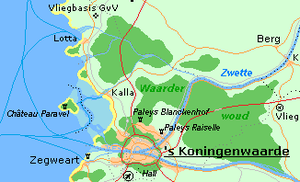Waarder Woud: Difference between revisions
No edit summary |
No edit summary |
||
| Line 7: | Line 7: | ||
==History== | ==History== | ||
Nowadays the forest is much smaller than the original size. To the west, part of the forest has disappeared as a result of the [[St. Lucia's flood]], which also caused [[Château Paravel|Paravel]] to emerge as an island. The connection with the [[ | Nowadays the forest is much smaller than the original size. To the west, part of the forest has disappeared as a result of the [[St. Lucia's flood]], which also caused [[Château Paravel|Paravel]] to emerge as an island. The connection with the [[Hoog Falwawoud]] has completely disappeared as a result of deforestation over the centuries. That deforestation has reduced the forest around it to its current form, especially for the benefit of agriculture. The advancing city has bordered the forest on the south side. | ||
With the construction of the [[Blanckenhof Palace]], the king has ensured joint management of the forest among all owners. There is still debate about the precise boundaries of the forest, mainly due to the new building plans of the city 's Koningenwaarde to the west of the railway 's Koningenwaarde - Kalla. There are also plans for reforestation to, for example, reconnect with the Hoog Falwawoud. | With the construction of the [[Blanckenhof Palace]], the king has ensured joint management of the forest among all owners. There is still debate about the precise boundaries of the forest, mainly due to the new building plans of the city 's Koningenwaarde to the west of the railway 's Koningenwaarde - Kalla. There are also plans for reforestation to, for example, reconnect with the Hoog Falwawoud. | ||
Revision as of 17:21, 19 April 2019
The Waarder Woud is a forest to the north-east of 's Koningenwaarde. The forest is largely owned by the Archduchy 's Koningenwaarde, a small portion is owned by the House of Vinandy and a small portion by the city 's Koningenwaarde.
The name "Waarder Woud" is a combination of "valuable" or "of value" and "forest". The Batavians distinguish two words, "wood" (Dutch: bos) (a tree-rich area) and "forest" (Dutch: woud) (a large forest). The Waarder Woud is the smallest of forests and an exception in the definition of 'woud'.
History
Nowadays the forest is much smaller than the original size. To the west, part of the forest has disappeared as a result of the St. Lucia's flood, which also caused Paravel to emerge as an island. The connection with the Hoog Falwawoud has completely disappeared as a result of deforestation over the centuries. That deforestation has reduced the forest around it to its current form, especially for the benefit of agriculture. The advancing city has bordered the forest on the south side.
With the construction of the Blanckenhof Palace, the king has ensured joint management of the forest among all owners. There is still debate about the precise boundaries of the forest, mainly due to the new building plans of the city 's Koningenwaarde to the west of the railway 's Koningenwaarde - Kalla. There are also plans for reforestation to, for example, reconnect with the Hoog Falwawoud.
Vegetation
The landscape of the Waarder Woud is dominated by a variety of deciduous trees, in particular beech, oak and ash. This combination of tree species is ideal for a unique spectacle in the spring. Then the forest turns blue purple when the Hyacinthoides non-scripta starts to flower.
Access
The forest around the Blanckenhof Palace is not open to the public. In the past there was also a fence, but that also blocked the passage for animals, such as deer and foxes. Paths have been laid out in a part of the forest. Shuttle buses are used during the flowering period of the Hyacinthoides non-scripta.


